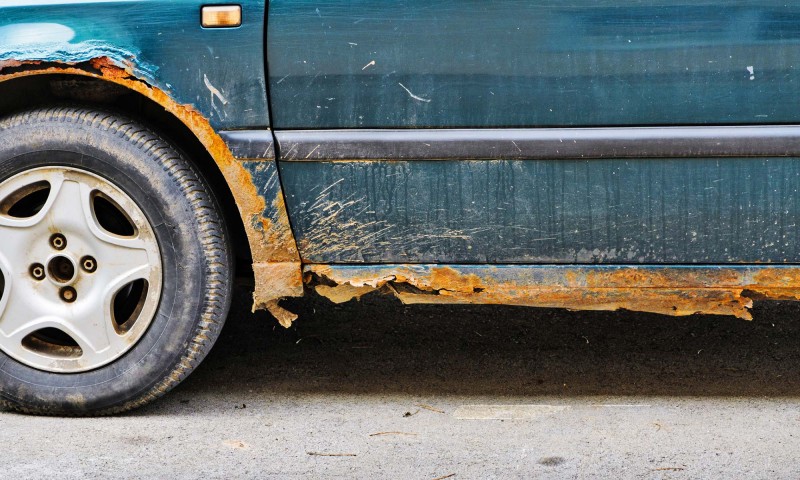
Rust, that insidious enemy of all vehicles, stealthily infiltrates your car's metal components, corroding them until they weaken and crumble. But fear not! Armed with the right knowledge and proactive measures, you can effectively shield your precious wheels from this relentless foe.
Before delving into prevention strategies, it's crucial to identify the areas most susceptible to rust:
The undercarriage of your vehicle faces significant exposure to road salt, moisture, and debris. These elements, particularly prevalent during winter months or in regions with coastal climates, can accelerate rust formation.
The accumulation of dirt and moisture in the wheel wells provides an ideal breeding ground for rust. This area is often overlooked during routine cleaning but requires special attention to prevent corrosion.
Door edges are frequently in contact with moisture and dirt, making them prone to rust formation over time. Neglecting to address this area can result in unsightly and potentially damaging corrosion.
Water can easily accumulate in the nooks and crannies of the trunk and hood, especially around the edges. This trapped moisture, combined with exposure to environmental contaminants, can lead to rust development if left unchecked.
Now that we've identified the rust-prone areas, let's discuss proactive steps to fend off corrosion effectively:
Frequent washing is essential to remove corrosive substances like road salt, grime, and bird droppings from your car's surface. These contaminants can accelerate rust formation if left untreated, making regular cleaning a crucial preventive measure.
Applying a coat of wax to your car's exterior creates a protective barrier that helps repel moisture and contaminants. This barrier not only enhances the shine of your vehicle but also acts as a shield against rust, prolonging the life of your paint job.
Rust inhibitor sprays are specially formulated to penetrate rust-prone areas and create a protective barrier against corrosion. Regular application of these sprays to vulnerable areas such as the undercarriage and wheel wells can significantly reduce the risk of rust formation.
Undercoating involves applying a protective sealant to the underside of your vehicle, creating a barrier between the metal components and the elements. This additional layer of protection helps shield the undercarriage from moisture, road salt, and debris, reducing the likelihood of rust development.
Professional rust proofing services offer a comprehensive solution for protecting your vehicle against corrosion. These treatments typically involve applying a specialized coating to vulnerable areas, sealing them off from moisture and environmental contaminants. While rust proofing may require a financial investment, the long-term benefits in terms of rust prevention and vehicle longevity are well worth it.
Vigilance is key when it comes to rust prevention. By being aware of the early warning signs of rust, you can take prompt action to address the issue before it escalates:
Bubbles forming beneath the paint surface are a clear indication of rust lurking beneath. If you notice any unusual bulges or blisters on your car's exterior, it's essential to investigate further to determine the extent of the rust damage.
Changes in the color or texture of your car's paint can signal the presence of rust. Keep an eye out for any areas where the paint appears dull, faded, or discolored, as these may be indicative of underlying corrosion.
Peeling or flaking paint is often a sign of rust developing beneath the surface. If you notice any areas where the paint is beginning to chip away or peel off, it's essential to address the issue promptly to prevent further corrosion.
If you spot any signs of rust on your vehicle, it's crucial to take swift action to address the issue before it worsens:
Sand away the affected area to remove any rust and apply a fresh coat of paint to prevent further corrosion. This DIY approach can be effective for minor rust damage but may require professional assistance for more extensive repairs.
Rust converters are chemical compounds that chemically transform rust into a stable compound, preventing further corrosion. These products are available in spray or brush-on formulations and can be an effective solution for halting the spread of rust.
For extensive rust damage or areas that are difficult to access, seeking professional auto body repair services is recommended. A skilled technician can assess the extent of the damage and implement the necessary repairs to restore your vehicle's appearance and structural integrity. In the battle against rust, prevention is your best defense. By staying vigilant, adopting proactive measures, and addressing any signs of rust promptly, you can keep your car looking sleek and rust-free for years to come. Remember, a little maintenance now can save you from costly repairs down the road!
You will get a celebrity look on Valentine's Day, just style your denim dress like this
Banita Sandhu Shines with Classic Elegance: A Closer Look at Her Timeless Fendi First Clutch
If you want to impress your partner in desi style then make it better with earrings